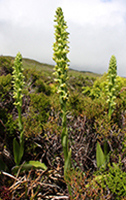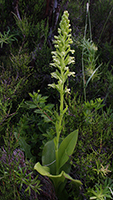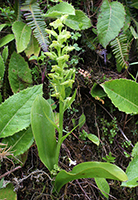Platanthera Species in the Azores − Summary of the Paper
The Azores are a remote cluster of islands situated 1600km from Iberia, 2000km from Morocco and 2300km from Canada. Given their isolation, the islands' Butterfly Orchids must have started out as the product of wind blown seed, with further evolution taking place separated from the source of that seed. In a recent paper published in the on-line scientific journal Peer J, Richard Bateman, Paula Rudall and local botanist Mónica Moura present some of their research into the present distribution, taxonomy and origins of Platanthera species in the Azorean archipelago. Their findings resolve some long standing taxonomic controversies and set the scene for knowledge based decision making about future conservation of these orchids.
The published work encompassed both detailed field research on the different islands and, importantly, herbarium samples derived from the very first known study of the Azorean Butterfly Orchids. The observations and discoveries developed into a detective story of some complexity. The use of comprehensive morphometric analysis proved a powerful tool that defined three distinct Platanthera species and managed to match these extant species to herbarium specimens that date from 1838. Investigation of the latter revealed that the names in general use for the two recognised Azorean species did not match those of the same entities preserved since 1838 and furthermore led to the discovery of a third herbarium specimen that had been overlooked for over a century and a half. Because there are internationally imposed rules that govern the naming of species, the "in use" Linnaean binomials had to be revised. Also, the discovery of a third species of Platanthera on the islands demanded a new name. Another value of the work is that it provides a scientific basis for the setting of conservation priorities and challenges a recent decision to lump together these distinct Platanthera species on the IUCN Red List. The three species that were defined in this work and their relationship to the past, generally recognised species follows.
Platanthera pollostantha (new name but it was formerly referred to as P. micrantha) The most widespread Platanthera species on the Azores Authors' recommended conservation status: Vulnerable |
 |
Platanthera micrantha (formerly referred to as P. azorica) Rarer than P. pollostantha and an indicator of semi-natural laurisilva habitat Authors' recommended conservation status: Endangered |
 |
Platanthera azorica (rediscovered by the authors but known as a herbarium specimen from 1836) Only a single known site − possibly the rarest orchid species in Europe Authors' recommended conservation status: Critically Endangered |
 |
Although the authors applied an impressive battery of measurements and detailed analyses they were nonetheless able to distil a monumental body of data into a straightforward quick key to distinguish the three species:
| 1 | Labellum >7mm, strongly reflexed; lateral sepals >7mm; viscidia >2mm apart | Platanthera azorica |
| 1* | Labellum <7mm, vertical/slightly reflexed; lateral sepals <7mm; viscidia <2mm apart | go to 2 |
| 2 | Labellum projecting forward and curving upward; spur >5mm; lateral sepals nearer vertical than horizontal | Platanthera micrantha |
| 2* | Labellum near-vertical, apex recurved; spur <5mm; lateral sepals nearer horizontal than vertical | Platanthera pollostantha |
The relationship of the Azorean Platanthera to other species around the world provided clear evidence that the founding wind blown seed originated from Europe rather than North America. Interestingly, two of the three species (P. pollostantha & P. micrantha) have superficial affinity with our own Lesser Butterfly Orchid (Platanthera bifolia), whereas the newly rediscovered P. azorica is more like our Greater Butterfly Orchid (Platanthera chlorantha). This raises an interesting question as to whether there were in fact two colonisation events from different sources of wind blown seed or whether, as seems more likely, these distinctions evolved over time within the isolation of the Azorean archipelago.
CLICK HERE to view the original PEER J publication
Richard M. Bateman, Paula J. Rudall and Mónica Moura (2013)
Systematic revision of Platanthera in the Azorean archipelago: not one but three species, including arguably Europe’s rarest orchid.
Video Killed the Media Star? Richard Bateman's Reflections on
Wild Orchids in the Modern Media
Modest beginnings
A fair proportion of Hardy Orchid Society members may recall that, in Kidlington Town Hall on Sunday 22nd April 2012, I gave my first-ever detailed presentation of some research that I and my colleagues had begun in the previous June on the butterfly-orchids (Platanthera) of the Azores. At that time, the research was seriously incomplete and wholly unpublished, but I took the risk of including in my talk all of our major conclusions to date. I did so anticipating (correctly) that, as usual, the talk would result in an excellent, well-informed question-and-answer session and so would yield valuable comments that could be fed back into the ongoing research.
I confess that I wasn’t entirely surprised when one over-enthusiastic member of the audience immediately posted on a birder’s website the most sensitive of all my preliminary conclusions – the hitherto essentially unknown occurrence of a third, exceptionally rare species of Platanthera to add to the two already reported from the Azores, now named Hochstetter’s Butterfly-orchid. Predictably, this premature posting soon sparked the interest of other orchid enthusiasts, encouraging me to complete the ensuing research papers and associated articles with more than my usual haste. The first paper was published at noon on 10th December 2013 by the newly-established open access journal PeerJ, immediately becoming freely available as a pdf to anyone possessing sufficient fortitude to digest it (https://peerj.com: warning – the 86 page pdf, rich in colour plates, weighs in at an impressive 23 Mb!).
Silk purses versus sow’s ears
However, the founders of PeerJ – an admirably innovative and forward-looking journal – have identified additional ways of expressing their inherent egalitarianism. One of these proved to be their determination to formulate a press release to accompany the publication of what was surely, to the casual observer, a turgid, data-rich monograph of just three species of rather uncharismatic green-flowered orchids. Even more unusually (at least, in my experience), PeerJ allowed me – a mere scientist – to draft the relevant press release! Admittedly, I found digesting 86 pages of scientific prose into a single page of semi-scientific prose to be no easy task, and choosing three accompanying illustrations from among the 82 published in the paper proved equally challenging. But needs must. The press release was duly completed and sanctioned for distribution a scant week before the scheduled publication date. My co-authors and I then sat back to see what, if anything, would transpire once the news embargo was lifted, anticipating (wrongly) the proverbial damp squib.
Most of my previous media experience occurred in the nineties and early noughties. On one occasion, I was interviewed al fresco while straddling a huge fossil log. The director decided that greater dynamism would be achieved by having his photographer circumnavigate myself and interviewer during the interview, and he was not mistaken – after completing three-quarters of his planned circuit, the photographer reversed over the log and instantly disappeared in a tangled heap of cameras, counterbalances and cables. I recall particularly vividly being dragged reluctantly into the fray, wearing my palaeobotanist’s hat, when demolition of part of a wall of the Royal Scottish Museum revealed that one of the excised blocks of stone contained a large (if poorly preserved) fossil clubmoss. I was astonished to be quoted, with varying degrees of accuracy, in most of the UK daily newspapers. Even more embarrassingly, I was persuaded by a Scottish news channel to be filmed trollying the aforementioned over-hyped rock across the main atrium of the museum. Resplendent in a pristine but totally superfluous lab coat, and directed to travel at a funereal pace, I resembled nothing more than a distressingly arthritic mortician.
It’s certainly instant but is it gratifying?
Such past ‘glories’ had not prepared me for the instantaneous feeding frenzy that characterises media interest the age of twitter, facebook and the ever-expanding blogosphere. Admittedly, only four journalists contacted me about the PeerJ press release in search of further quotes and/or clarifications, but they were at least representing (in contrasting ways) notable organisations. Three – the BBC, the American broadcaster NBC, and the online specialists LiveScience – approached me just before the embargo was lifted, and their online articles went live within an hour of the deadline. The fourth inquirer, representing the Daily Mail, waited until the following day to hit the newsstands. By 5 pm on the first day, about two dozen websites and blogs had picked up and ‘borrowed’, in part or in their entirety, one of those first three articles. And by the following morning that number had doubled. These days, news travels very, very fast.
Faced with such media novae, it is tempting to focus on determinedly salacious comments seemingly posted by aspirant shock-jocks. Hardy Orchid Society members, only too well aware that new orchid species are literally described every day and new European orchid species at an average rate of perhaps one per fortnight, may have some sympathy with one underwhelmed commentator. Proudly identified as a ‘Platinum Member’ of the online Orchid Source Forum and wisely hiding behind an alias, “MrCym” admitted that ‘I'm just abuzz with excitement … don't they have Paraquat available to do the decent thing? These boring terrestrials should be exterminated’. And disgruntled taxpayers everywhere may empathise with a Daily Mail online commentator, operating under the reassuring sobriquet “Onelife”, who demanded to be told ‘Who pays for these botanists to live their idyllic lives, and for what purpose, I don't believe what they do serves any real purpose, just a subsidized self important well paid jaunt.’ Well, don’t panic, Onelife: all three of us largely funded the Azorean fieldwork out of our own pockets, aided by small subsidies from two botanical charities who fortunately adopted a slightly less vengeful position on the value of biodiversity studies designed to aid wildlife conservation.
But my laurels go to the Daily Mail itself, awarded for its enthusiasm to fix a bounty on the head of each rare orchid and the resulting subheading: “There were [note the use of the past tense!] only 250 plants of the unique species on island: each plant could be worth a substantial sum to collectors.” Well, actually, Daily Mail, that outcome is pretty unlikely … unless you yourselves help to manufacture a market by concocting characteristically provocative headlines such as this.
Listen very carefully – I shall say zis only once
More relevant dialogues, developed on several websites, concerned a linked topic that has long exercised Hardy Orchid Society members – the wisdom or otherwise of drawing people’s attention to the presence of a rare orchid. Comments advocating secrecy routinely drew plenty of ‘likes’ and very few ‘dislikes’. And it is indeed true that the press release, and some of the resulting articles, reveal which of the nine islands supports the rarest of the three butterfly-orchids, while the PeerJ paper also discloses the identity of (and illustrates, on a rare fog-free day) the closest volcanic peak.
But there is still plenty of work required by an orchid enthusiast to find the plants, quite apart from the considerable time and expense of reaching these remote islands in the first place. The plant itself has such exacting ecological and climatic requirements that it is very unlikely to succeed in cultivation, and in any case, it is both rather uncharismatic in appearance and closely resembles Holmboe’s Butterfly-orchid. This orchid will be familiar to any orchid enthusiast who has paid a late-spring visit to the eastern Mediterranean, where it is accompanied by many other orchids. In contrast, the Azorean archipelago is no orchidological paradise. Supplementing their butterfly-orchids with two tongue orchids, the islands are a decidedly specialist destination for orchid enthusiasts. Overall, I’m confident that no-one is going to make a profit out of Hochstetter’s Butterfly-orchid.
I would emphasise the fact that pitched against the risk of plunder are several possible gains from publicity. Firstly, Hochstetter’s Butterfly-orchid has escaped the attention of numerous botanists through the last 175 years, and we are confident that the original find took place on a different Azorean island. The more pairs of eyes now seeking this newly-recognised species on all the islands the better. But most importantly, anyone visiting the islands will immediately recognise the considerable threats posed to all three Azorean Butterfly-orchids by habitat destruction and encroachment by virulently invasive plants such as Himalayan ginger. Yet conservation measures on the islands are severely limited and have not been helped by Portugal’s chronic financial woes. The Butterfly-orchid habitats are among the best on the islands and therefore, in my opinion, merit all the publicity they can get. These orchids urgently need to be placed more firmly on the conservation map.
Journalistic homeopathy
I must confess that my post hoc interest the PeerJ press release was less in how much ‘market penetration’ could be achieved and more in whether key facts and ideas could be disseminated successfully. There is always the hope that simple facts and analogies can be used as stalking horses for more complex (and thus less palatable) storylines.
In this case, I especially wished to emphasise that bona fide science in general, and taxonomy in particular, is evidence based. What in my view made the new Azorean species special was that it was a demonstrable, evidence-based new species, rather than a hypothetical new species reflecting a few hastily made, near-random observations. The research team surveyed the orchids of all nine Azorean islands. The morphological studies of the orchids, and DNA-based studies of both the orchids and their mycorrhizal fungi, came together to tell different parts of the overall story. And information from libraries and herbaria eventually allowed me to deduce that the first botanist to visit the islands, Karl Hochstetter, had probably found and recognised all three Azorean butterfly-orchids, but had been overruled by his better established botanist father, who recognised only two species. Who had in turn been overruled in recent years by the International Union for the Conservation of Nature, who – for reasons best known to themselves – recognised only one species. These taxonomic decisions had profound downstream consequences.
But reality soon strikes when you are faced with reducing an 86-page research article to a one-page press release; there simply is insufficient room to accommodate both the ‘hooks’ and the hard science. The same predicament faces the journalist preparing a popular article from the press release – plus, in the case of particularly rigorous individual, parsing through the article and/or quizzing the author(s). Within hours, the secondary sites have borrowed wholesale from either the press release and/or the primary sites, and innumerable online commentators are free to add their own pearls of wisdom. By this point in the dissemination of knowledge, 86 pages of science have been repeatedly diluted to leave the equivalent of a 140-character tweet. I can think of only one circumstance that is more stringently homeopathic – during general elections, we are permitted just one pencil cross with which to sanction all government policies for the next five years. Both acts require considerable courage, as well as rigorous management of downstream expectations.
Is a (moving) picture worth a thousand words?
Overall, the last few days have taught me that journalism now operates on a mind-bogglingly short time-scale. This story began within a minute of the lifting of the news embargo and was largely concluded within the first 36 hours. It also reinforced several previous lessons that may prove relevant to any budding purveyor of popular science. Do not expect to have complex messages picked up by the media. Do not be surprised by the introduction of the most simple of errors – an archipelago located west of Portugal may in print suddenly be relocated west of Spain or, even more miraculously, placed off the coast of Brazil. Beware lines of persistent questioning that imply a pre-written sensationalist headline – the resulting article is unlikely to make you deliriously happy. And do not expect non-scientists to be an interested in evidence as you are – most journalists consider only conclusions and consequences.
Lastly, if you really wish to maximise your fame (trust me, you can forget fortune!), take a video of any dramatic aspect of your discovery. The first journalist to contact me regarding the Azorean orchids represented Reuters, but he was interested only in obtaining video footage. As a result of my failure to record our (re)discovery with sufficient gravitas, I may have missed out on having the Azorean orchid story syndicated world-wide. I can’t say that I’m feeling all that deprived. And I guess there’s always YouTube …